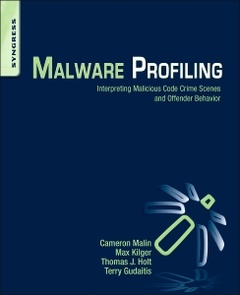Deception in the Digital Age Exploiting and Defending Human Targets through Computer-Mediated Communications
Auteurs : Malin Cameron H., Gudaitis Terry, Holt Thomas, Kilger Max

Deception in the Digital Age: Exploiting and Defending Human Targets Through Computer-Mediated Communicationguides readers through the fascinating history and principles of deception?and how these techniques and stratagems are now being effectively used by cyber attackers. Users will find an in-depth guide that provides valuable insights into the cognitive, sensory and narrative bases of misdirection, used to shape the targeted audience?s perceptions and beliefs.
The text provides a detailed analysis of the psychological, sensory, sociological, and technical precepts that reveal predictors of attacks?and conversely postmortem insight about attackers?presenting a unique resource that empowers readers to observe, understand and protect against cyber deception tactics.
Written by information security experts with real-world investigative experience, the text is the most instructional book available on the subject, providing practical guidance to readers with rich literature references, diagrams and examples that enhance the learning process.
1. The Psychology of Deception 2. Virtual Myths: Internet Urban Legend, Chain Letters, and Warnings 3. Viral Influence: Deceptive Computing Attacks through Persuasion 4. Social Dynamics of Deception: Cyber Underground Markets and Cultures 5. Phishing, Watering Holes, and Scareware 6. Seeing is not Believing: Deceptive Internet Video Communications 7. e-Jihad: Jihadist Use of Cyber Denial and Deception 8. Asymmetric Warfare and Psyops: Nation State Sponsored Cyber Attacks 9. Sweet Deception: Honeypots 10. Looking Forward
Dr. Terry Gudaitis is the Owner/Principal of Mindstar Security & Profili
- Deeply examines the psychology of deception through the lens of misdirection and other techniques used by master magicians
- Explores cognitive vulnerabilities that cyber attackers use to exploit human targets
- Dissects the underpinnings and elements of deception narratives
- Examines group dynamics and deception factors in cyber attacker underground markets
- Provides deep coverage on how cyber attackers leverage psychological influence techniques in the trajectory of deception strategies
- Explores the deception strategies used in today’s threat landscape—phishing, watering hole, scareware and ransomware attacks
- Gives unprecedented insight into deceptive Internet video communications
- Delves into the history and deception pathways of nation-state and cyber terrorism attackers
- Provides unique insight into honeypot technologies and strategies
- Explores the future of cyber deception
Date de parution : 10-2017
Ouvrage de 284 p.
19x23.3 cm
Thèmes de Deception in the Digital Age :
Mots-clés :
Asymmetric warfare; Augmented reality; Chain letter; Cognitive illusions; Cognitive vulnerabilities; Conjuring; Cover and concealment; Cyber Caliphate; Cyber espionage; Cyber nationalism; Cybercrime culture; Cybercrime markets; Cybercrime; Cyberwarfare; Dabiq; Dark markets; Dark web; Deception toolkit; Decoy; Disruptive technology; Drones; Early photography; Electronic jihad; Email hoax; Film fakes; Game theory; Ghost army; High interaction honeypot; Hoax viruses; Holograms; Honeychannel; Honeynet Project; Honeynet; Honeypot; Honeytoken; Hybrid conflict; Illegal cyber services; Inattentional blindness; Internet hoax; Interpersonal deception theory; Jihad; Jihadi cyber attack; Jihadi historical narrative; Jihadi online fundraising; Low interaction honeypot; Magic; Man in the middle; Mimicking; Misdirection; Motion pictures; Nanotechnology; Neurohacking; Neuromarketing; Neuropsychology; Nonnation state actors; Nonverbal cues; Online communities; Online folklore; Online social cues; Online social dynamics; Online urban legend; Online urban myth; Persuasion in computer mediated communications (CMC)Persuasive communications; Persuasion; Persuasive technology; Phishing; Phoneytoken; Propaganda; Psychological influence; Psychology in cyber attacks; Psychology in hacking; Psychology of hacking; Psychology; Psyops; Quantum stealth; Ransomware; Recruitment; Scare chains; Scareware; Social dynamics; Social engineering; Social influence; Social media; Sock puppeting; Spear phishing; Steganography; Strategic web compromises; Stuxnet; Tech support scams; Threat chains; Trust in cybercrime underground markets; Underground markets; Urban legend; Urban myth; Video production; Video software; Virtual no-flag operations; Watering hole attacks



